Best Winter Bike Tires 2025: Studded & Non-Studded Options for Snow & Ice

Bike Legal COO and avid cyclist advocating for sharing the road responsibly.
Winter cycling comes with unique challenges, from icy roads to unpredictable traction. The right winter bike tires can mean the difference between a safe, controlled ride and a dangerous slip. Whether commuting, training, or tackling snowy trails, choosing the right studded or non-studded tires is essential for grip, stability, and performance. In this guide, we’ll break down the best winter bike tires for 2025, covering key features, expert recommendations, and tips to keep you riding confidently all season long
- Key features of winter bike tires
- Best tire picks for road cyclists, commuters, and more
- Product reviews and recommendations
- Tips for choosing and maintaining winter tires
TL;DR: Best Winter Bike Tires 2025
- Winter Bike Tires 2025: Choose based on riding style (road, commute, gravel), conditions (ice, snow, mixed), and budget.
- Key Features: Aggressive tread, cold-weather compound, appropriate width.
- Studded vs. Non-Studded: Studded = ice, Non-studded = mixed conditions.
- Riding Styles:
- Road: Prioritize grip/efficiency (competitive) or comfort/stability (recreational). Examples: Continental Top Contact Winter II Premium (competitive), Schwalbe Marathon Winter Plus (recreational).
- Urban Commute: Icy patches, slush, puncture protection. Example: MOHEGIA Cruiser Bike Replacement Tire.
- Gravel: Versatile for snow, ice, gravel. Example: 45NRTH Dillinger.
- Budget: Affordable options exist (e.g., Schwalbe Winter).
- High-Performance: Extreme conditions (e.g., Schwalbe Ice Spiker Pro).
- Maintenance: Proper inflation, stud inspection (if applicable), correct storage.
- Considerations: Regional weather, avoid summer tires, don't overestimate studded tire grip.
- Emerging Tech: Graphene, self-healing punctures.
- Tire Types: Studded, tubeless, clincher - each with pros/cons.
Key Features to Look for in Winter Bike Tires
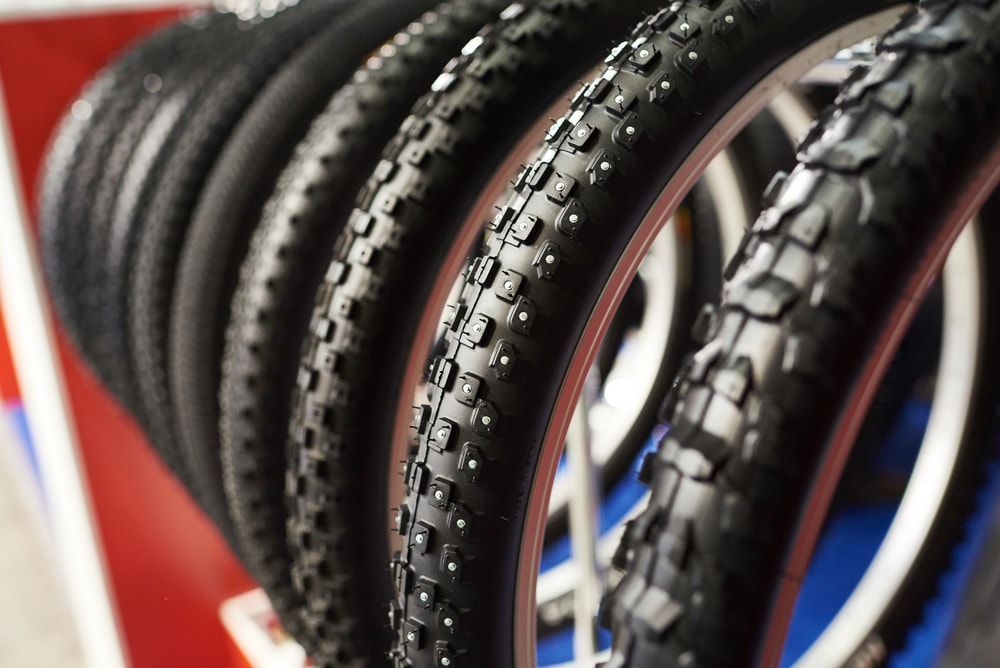
Choosing the right winter bike tire can feel overwhelming. There are so many options. But don't worry; we'll break down the essential features to consider. Focus on these key elements, and you'll be well on your way to a safer winter ride.
Choosing the right winter bike tires is just one part of riding safely in the cold. Our complete guide to bicycling outdoors in winter covers everything from layering to handling icy roads like a pro.
Traction and Grip: The Heart of Winter Performance
Traction is king in winter. It's what keeps you upright and moving forward. Several factors contribute to a tire's grip:
- Tread Design: Look for tires with aggressive tread patterns. Sipes (small slits in the tread blocks) are crucial for biting into snow and ice. The more sipes, the better the grip in slick conditions.
- Rubber Compound: Winter tires use special rubber tire compounds that stay pliable in cold temperatures. This allows the tire to conform to the road surface and maintain traction. Summer tires harden in the cold, losing their grip.
- Tire Width: Wider tires generally provide better traction on loose surfaces like snow. They distribute your weight over a larger area, preventing you from sinking in.
Studded vs. Non-Studded Bike Tires: Which is Best for You?
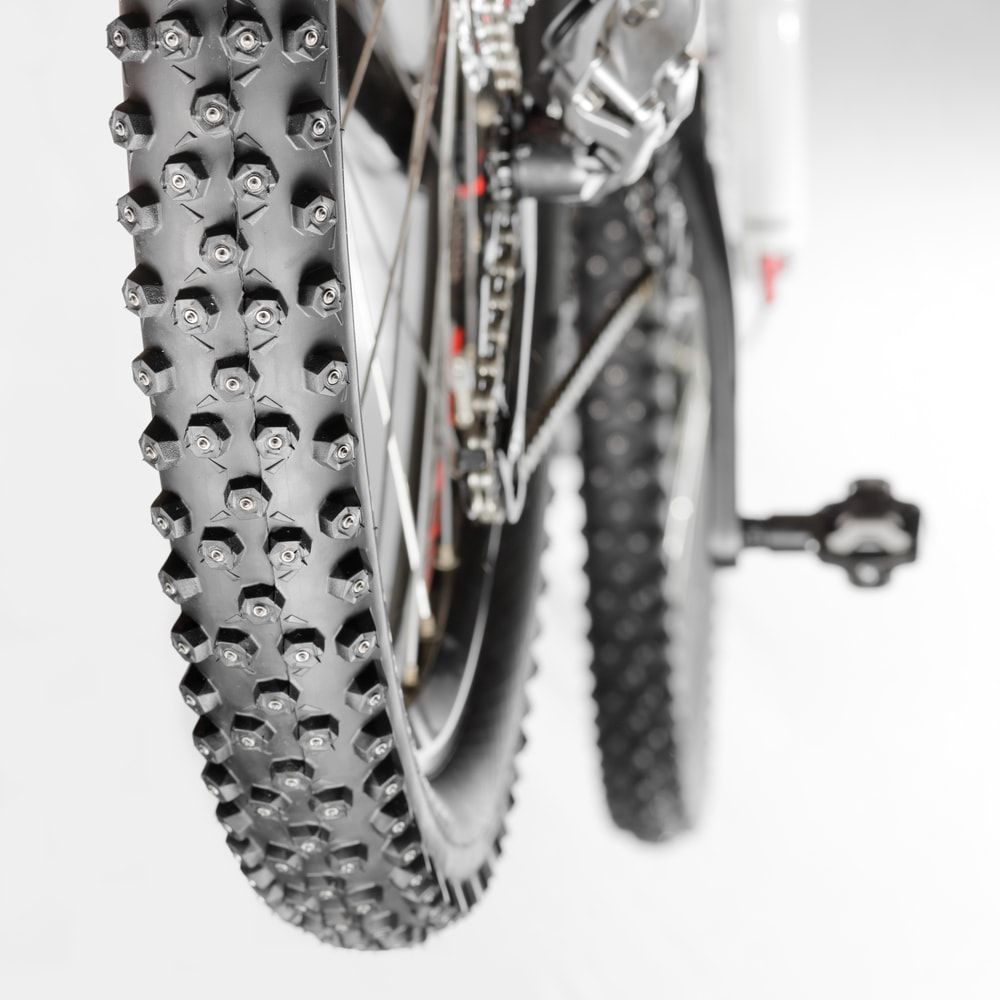
Studded tires are the ultimate weapon against ice. They feature small metal studs embedded in the tread that dig into the ice for incredible grip. However, they can be noisy and less efficient on clear pavement.
- Studded Tires: Best for consistently icy conditions. It offers maximum grip but can be noisy and less efficient on clear roads.
- Non-Studded Tires: Ideal for areas with occasional snow and ice. Offer a good balance of traction and rolling efficiency.
Non-studded winter tires can be a great choice for mixed conditions, including rain and slush. If you're wondering about wet-weather cycling, check out our guide on riding a bike in the rain for tips on staying safe and dry.
Compatibility: Tubeless or Clincher?
Tubeless tires are becoming increasingly popular for winter riding. They offer several advantages:
- Tubeless Tires: Can be run at lower pressures for better traction on snow and ice. Also, it is less prone to pinch flats.
- Clincher Tires: The traditional tire type. They are more affordable but can be more susceptible to punctures unless they are puncture-proof tires.
Consider your wheel setup and riding preferences when choosing between tubeless and clincher.
Durability: Built for Winter's Worst
Winter conditions can be harsh on tires. Salt, grit, and ice can wear down rubber quickly. Look for tires made with durable compounds and reinforced sidewalls to withstand the abuse.
Winter cycling means shorter days and reduced visibility. Make sure you're seen with the right bike lights—read our bicycle light lumens guide to learn how bright your lights should be for challenging weather conditions.
Size: Finding the Right Fit
Tire size plays a critical role in winter performance. Wider tires are generally better for snow and ice, but they can also add weight and rolling resistance. Consider your bike's clearance and your riding style when choosing a tire size. Lower tire pressure can also improve traction on snow and ice, but don't go too low, or you risk pinch flats.
Best Winter Road Tires by Category
Now that you know what to look for, let's explore some top tire picks for different riding styles. Whether you're a roadie, commuter, gravel grinder, or just looking for a budget-friendly option, we've got you covered.
| Tire Model | Price | Best For | Pros | Cons |
|---|---|---|---|---|
| Schwalbe Marathon Winter Plus | $75.44 | Commuters, Recreational Riders (Icy Conditions) | Excellent ice grip, high puncture protection, versatile performance, durable | Noisy on clear pavement, spikes may wear, higher rolling resistance |
| Continental Top Contact Winter II Premium | $78.95 | Performance Cyclists, Commuters, E-Bike Riders | Excellent grip on snow/wet, superior puncture protection, E-50 certified, foldable | Spikes not included, less effective on pure ice, higher price |
| CST Premium Toboggan | $78.02 | Fat Bike Riders (Extreme Winter) | Excellent traction in snow/ice, oversized design, more affordable | Noisy on pavement, may be overkill, wire bead |
| MOHEGIA Cruiser Bike Replacement Tire | $42.99 (2-pack) | Urban Commuters, Cruiser Riders | Good balance of rolling resistance and grip, puncture-resistant, affordable | Semi-slick tread (not ideal for slippery conditions), shipped folded, lower max PSI |
| 45NRTH Dillinger | $260.00 | Fat Bike Riders (Icy/Snowy Trails) | Exceptional ice grip, improved cornering, tubeless-ready, rolling speed on hardpack | High price, noisy on pavement, may be unnecessary |
| Schwalbe Winter | $49.81 | Commuters, Recreational Riders (Occasional Ice) | Good ice grip, lower rolling resistance, affordable | Less grip than Marathon Winter, spikes may wear, noisy on pavement |
| Schwalbe Ice Spiker Pro Performance DD | $113.72 | Mountain Bikers (Icy/Snowy Trails) | Unbelievable ice grip, durable construction, tubeless-ready, excellent puncture protection | High price, noisy on pavement, may be overkill |
For Road Cyclists
Recreational Road Cyclists
If you enjoy leisurely winter rides and prioritize comfort and stability, these tires are a great fit:
1. Schwalbe Marathon Winter Plus Tire
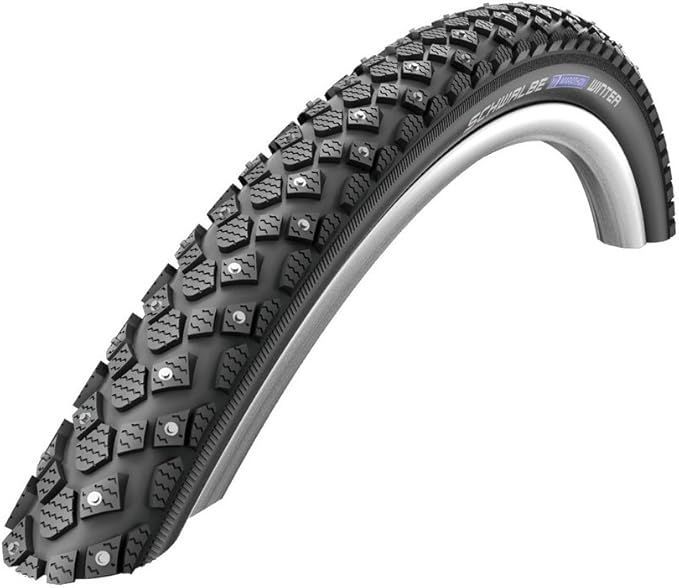
The Schwalbe Marathon Winter Plus is your trusted companion for navigating icy winter roads. This tire is built for control and safety, featuring a SmartGuard layer for top-notch puncture protection. The strategically placed spikes provide exceptional grip on ice, giving you the confidence to ride even in slippery conditions.
While the spikes offer maximum security on the ice at lower pressures, they minimize noise on clear roads when inflated to higher pressures, offering a versatile ride. Whether you're commuting or enjoying recreational rides, the Marathon Winter Plus keeps you rolling safely through the winter.
- Price: $75.44
- Best For: Commuters, recreational riders, cyclists in areas with icy conditions.
- Pros:
- Excellent grip on ice due to strategically placed spikes.
- High puncture protection with SmartGuard layer.
- Versatile performance on both icy and clear roads.
- Durable construction for long-lasting use.
- Cons:
- It can be noisy on clear pavement at lower pressures.
- Spikes may wear down over time.
- Higher rolling resistance compared to non-studded tires.
Competitive/Elite/Performance Road Cyclists
For those who refuse to let winter slow them down, these high-performance tires offer maximum grip and efficiency:
2. Continental Top Contact Winter II Premium
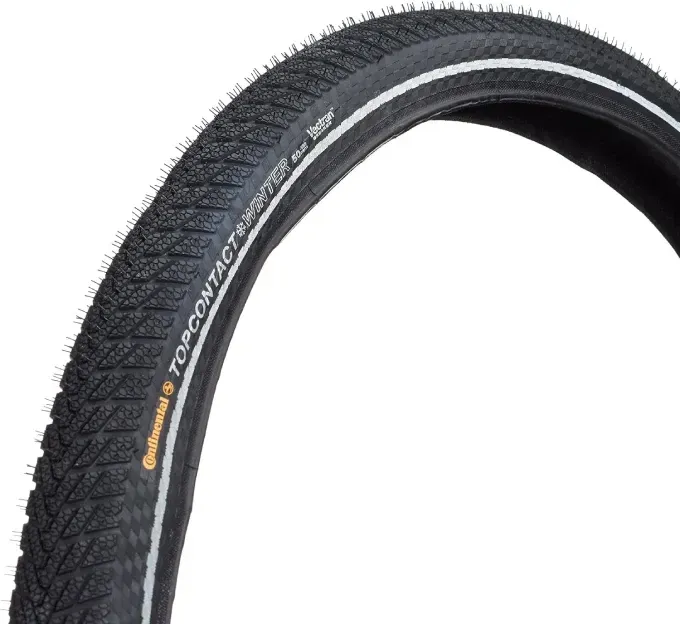
The Continental Top Contact Winter II Premium is a high-performance winter tire designed to give you confidence and control in challenging conditions. Its special winter tire compound and grippy lamellar tread pattern work together to provide excellent traction on snow-covered roads and wet, slippery surfaces.
The Vectran breaker offers top-notch puncture protection, while the tire's E-50 certification makes it suitable for e-bikes up to 50 km/h. Built with Continental's extensive experience in winter tire technology, the Top Contact Winter II Premium is a premium choice for serious winter cyclists. Note that this tire does not come with pre-installed studs, allowing you to customize your setup based on your specific needs.
- Price: $78.95
- Best For: Performance-oriented cyclists, commuters, and e-bike riders in areas with snowy or wet conditions.
- Pros:
- Excellent grip on snow and wet surfaces due to lamellar tread pattern.
- Superior puncture protection with Vectran breaker.
- E-50 certified for e-bikes up to 50 km/h.
- Foldable design for easy storage and transport.
- Cons:
- Spikes are not included and must be purchased separately if desired.
- It may be less effective on pure ice compared to studded tires.
- Higher price point compared to some other winter tires.
3. CST Premium Toboggan 26x4.0 Studded Tire
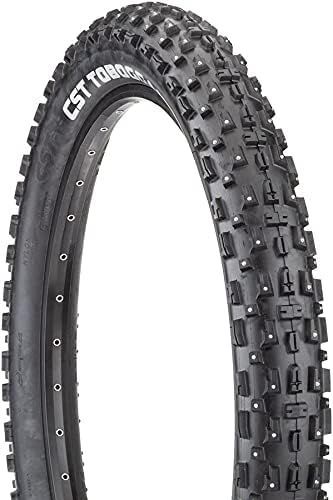
The CST Premium Toboggan is a big, bold tire designed for extreme winter fat biking. This oversized studded tire is built to handle the toughest conditions, providing excellent traction on loose snow and ice. The aggressive tread pattern and strategically placed studs dig into slippery surfaces, giving you the confidence to ride where others fear to tread. If you're looking for a fat bike tire that can handle anything winter throws your way, the CST Toboggan is a strong contender.
- Price: $78.02
- Best For: Fat bike riders tackling extreme winter conditions.
- Pros:
- Excellent traction in snow and ice due to aggressive tread and studs.
- Oversized design for maximum floatation and grip.
- More affordable than some other high-end studded fat bike tires.
- Cons:
- Studded tires can be noisy on the pavement.
- It may be overkill for riders in areas with less severe winter conditions.
- Wire bead can be more difficult to install than folding tires.
For Urban Commuters
Urban commutes can be treacherous in winter. These tires are designed to handle icy patches, slush, and everything else city streets throw at you:
4. MOHEGIA Cruiser Bike Replacement Tire
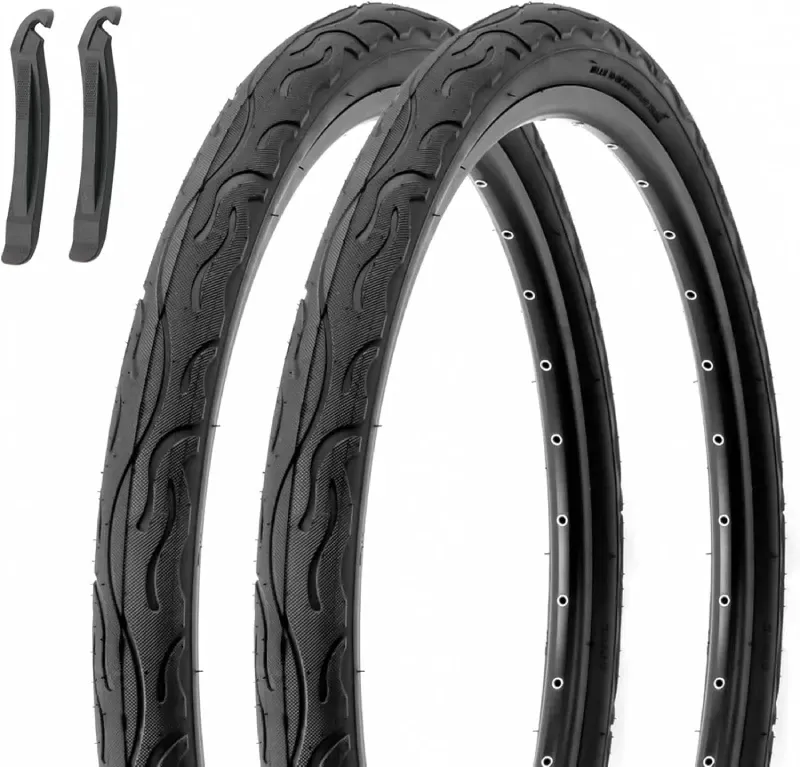
The MOHEGIA Cruiser Bike Replacement Tire is a versatile option for urban cyclists and commuters looking for a reliable and comfortable ride. This 2-pack of 26 x 2.125-inch tires features a semi-slick tread pattern that balances low rolling resistance for efficient commuting with good grip and maneuverability for city streets.
The strong nylon casing and durable rubber compound offer excellent puncture resistance and long-lasting wear, making these tires a practical choice for daily riding. Note that these tires are shipped folded and should be unfolded and allowed to rest for 1-2 days before installation.
- Price: $42.99 (2-pack)
- Best For: Urban commuters, cruiser bike riders, city cyclists.
- Pros:
- Good balance of rolling resistance and grip.
- Puncture-resistant construction for added durability.
- Affordable price point (especially as a 2-pack).
- Suitable for a variety of urban riding conditions.
- Cons:
- Semi-slick tread pattern may not be ideal for off-road or very slippery conditions.
- Tires are shipped folded and require time to regain their shape.
- Maximum inflation pressure of 40 PSI may not be suitable for all riders.
For Gravel Riding
Gravel riding in winter opens up a whole new world of adventure. These tires offer the versatility you need to tackle snowy trails and icy roads:
5. 45NRTH Dillinger 27.5-inch Tire
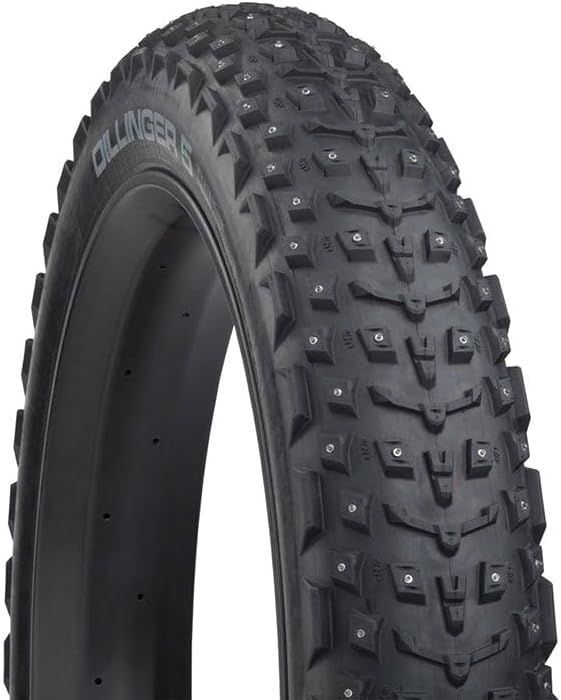
The 45NRTH Dillinger is a serious tire for serious winter fat bikers. Redesigned with an aggressive tread pattern and tubeless compatibility, this tire is built to conquer icy trails and snowy conditions. 252 strategically placed studs provide exceptional grip on ice, allowing you to confidently tackle challenging terrain. Taller side lugs enhance cornering in snow, while the tightly spaced center tread ensures speed when you need it. If you're looking for maximum performance and control on your winter fat bike adventures, the Dillinger is ready to deliver.
- Price: $260.00
- Best For: Fat bike riders tackling icy and snowy trails.
- Pros:
- Exceptional ice grip with 252 strategically placed studs.
- Improved cornering in snow due to taller side lugs.
- Tubeless-ready for enhanced performance and flat protection.
- Tightly spaced center tread for speed on hardpack.
- Cons:
- High price point compared to other winter tires.
- Studded tires can be noisy on the pavement.
- It may not be necessary for riders in areas with minimal ice.
Budget-Friendly Options
You don't have to break the bank to stay safe this winter. These affordable tires offer reliable performance without compromising quality:
6. Schwalbe Winter Tire
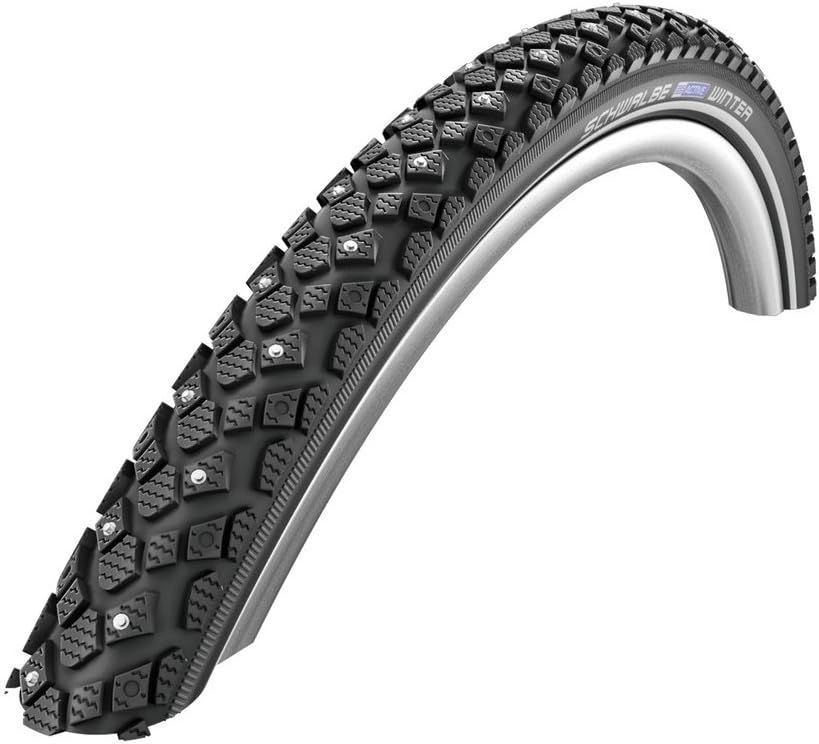
The Schwalbe Winter Road Tires offers reliable control on icy roads with a design that balances grip and efficiency. Featuring strategically placed spikes, this tire provides excellent traction on glassy ice, giving you confidence in slippery conditions.
While its grip isn't quite as extreme as the Marathon Winter, it still offers a high level of control. This makes it a good choice for riders who encounter icy patches but also spend time on clear pavement. The Schwalbe Winter provides a good balance between winter grip and rolling resistance.
- Price: $49.81
- Best For: Commuters, recreational riders in areas with occasional icy conditions.
- Pros:
- Good grip on ice due to strategically placed spikes.
- Lower rolling resistance compared to full-studded tires.
- More affordable than premium studded options.
- Cons:
- There is not as much grip on thick ice or deep snow as in the Marathon Winter.
- Spikes may wear down over time.
- It can be noisy on clear pavement.
7. Schwalbe Ice Spiker Pro Performance DD Spike Tire
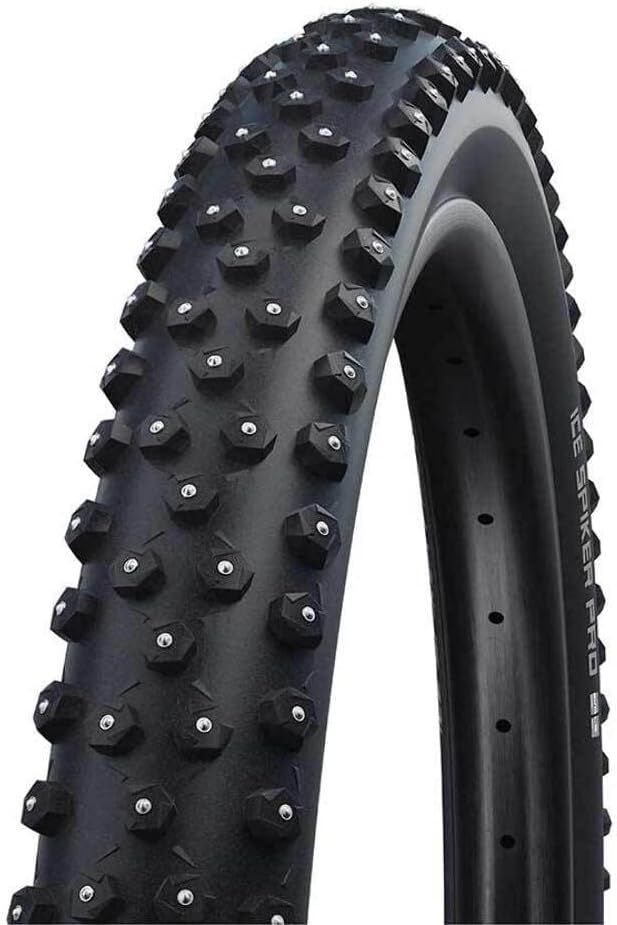
The Schwalbe Ice Spiker Pro is the ultimate weapon for mountain bikers who refuse to let winter stop their trail riding. Updated for 2021 with Schwalbe's Tubeless Easy (TLE) Double Defense Raceguard construction, this tire is tougher than ever.
It delivers unbelievable grip on frozen surfaces with up to 402 studs (in the 29x2.25" size), giving you the confidence to tackle icy climbs and technical descents. The Double Defense Raceguard provides excellent puncture protection, making it durable enough for rooty and rocky trails. If you're a serious winter mountain biker, the Ice Spiker Pro is the tire you need.
- Price: $113.72
- Best For: Mountain bikers riding icy and snowy trails.
- Pros:
- Unbelievable grip on ice with up to 402 studs.
- Durable construction with Double Defense Raceguard.
- Tubeless Easy (TLE) compatible.
- Excellent puncture protection.
- Cons:
- High price point.
- Studded tires can be noisy on the pavement.
- It may be overkill for areas with minimal ice or snow.
Remember to consider your specific needs and riding conditions when choosing your winter tires. This list is a great starting point for your search.
Tips for Choosing and Maintaining Winter Bike Tires
Choosing the right winter tires is only half the battle. Proper maintenance is essential for maximizing their performance and lifespan. Here are some key tips to keep in mind:
Selecting the Right Tire for Your Ride
Your riding style and conditions should dictate your tire choice. Let's break it down:
- Recreational Road Cyclists: Prioritize comfort and stability. Studless winter tires or tires with a less aggressive thick tread pattern are often sufficient for paved roads with occasional snow or ice.
- Competitive Road Cyclists: Look for high-performance tires that balance grip and rolling resistance. Studded tires might be necessary for races on icy courses.
- Urban Commuters: Choose tires that can handle a mix of conditions, including icy patches, slush, and wet roads. Puncture protection is also crucial for city riding.
Pairing your winter bike tires with the right gear is essential for staying warm and safe. Check out our guide to the best winter cycling gear for cold weather rides in 2025 to ensure you're fully prepared for any conditions.
Proper Tire Inflation for Winter
Tire pressure plays a huge role in winter performance. Cold temperatures can lower tire pressure, so it's important to check your pressure regularly. Lowering your tire pressure slightly can increase traction on snow and ice, but don't go too low, or you risk pinch flats. Refer to the tire sidewall for the recommended pressure range.
Stud Maintenance for Studded Tires
Studded tires require some extra care to ensure they last.
- Break-in Period: New studded tires benefit from a break-in period. Ride on clear pavement for a while to seat the studs properly. Avoid hard braking or acceleration during this time.
- Inspection: Regularly inspect your studded tires for loose or damaged studs. Replace any missing or damaged studs promptly to maintain optimal grip.
- Cleaning: Clean your studded tires regularly to remove dirt, salt, and debris. This will help prevent corrosion and prolong the life of the studs.
Seasonal Storage Tips
When winter is over, proper storage will keep your tires in good condition for the next season.
- Cleaning: Clean your tires thoroughly before storing them.
- Storage Location: Store your tires in a cool, dry place away from direct sunlight and extreme temperatures. Avoid storing them near ozone sources, such as electric motors or furnaces.
- Tire Position: Store tires either hanging or stacked horizontally. Avoid storing them vertically, as this can cause the sidewalls to deform.
Emerging Technology in Winter Tires
The world of winter tire technology is constantly evolving. Manufacturers are exploring new materials and designs to enhance performance and safety. Here are a couple of exciting advancements:
- Graphene-Enhanced Rubber: Graphene, a super-strong and lightweight material, is being incorporated into tire rubber compounds. This can improve grip, durability, and rolling resistance. Expect to see more graphene-enhanced winter tires in the future.
- Self-Healing Puncture Resistance: Some tires are being developed with self-healing properties. These tires can automatically seal small punctures, preventing flats and keeping you rolling. This technology is especially beneficial for commuters and riders who want to minimize downtime.
Regional Considerations for Winter Tires
Winter conditions vary significantly across different regions. Your tire choice should reflect the specific challenges you face.
- Extreme Cold Regions (e.g., Midwest, North): In areas with consistently low temperatures, heavy snowfall, and frequent ice, studded tires are often a necessity. Look for tires with a high number of studs for maximum grip. Consider wider tires for better floatation in deep snow.
- Mild Winter Areas (e.g., California, Arizona, Nevada): If you live in an area with milder winters, you may not need studded tires. Studless winter tires with a good tread pattern and cold-weather rubber compound should be sufficient for occasional snow or ice. Focus on tires that perform well in wet and cold conditions.
Common Mistakes to Avoid When Choosing Winter Tires
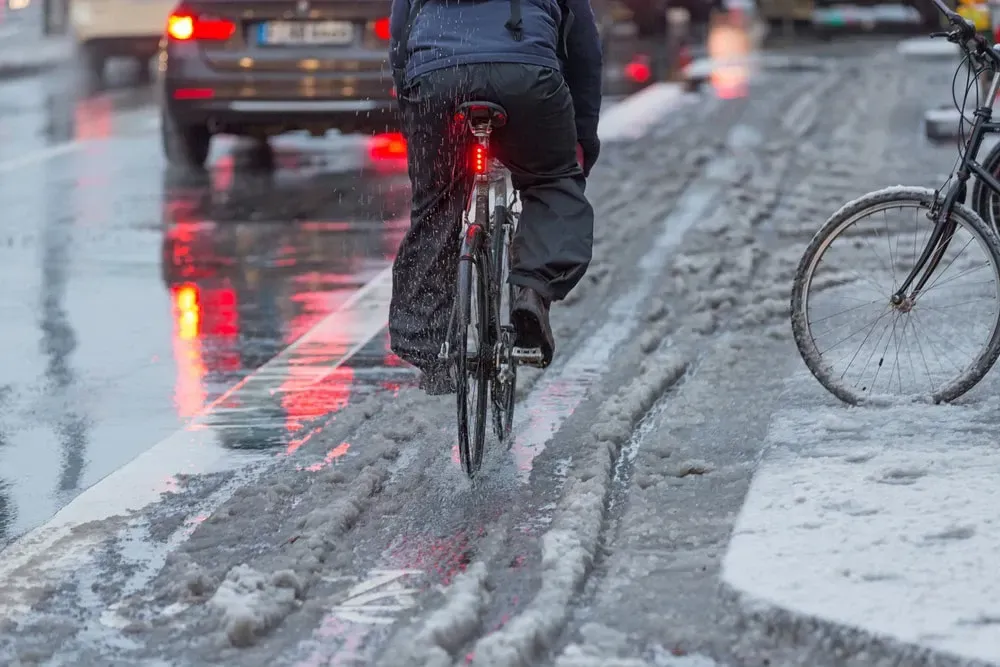
Choosing the right winter tires can be tricky, and it's easy to make mistakes. Here are some common pitfalls to avoid:
- Using Summer Tires in Winter: This is a major safety hazard. Summer tires are designed for warm temperatures and lose their grip in the cold. They can become hard and slippery, significantly increasing your risk of accidents.
- Improper Inflation: Both over- and under-inflation can negatively impact tire performance. Overinflation reduces traction, while underinflation can lead to pinch flats and poor handling. Always check your tire pressure regularly and inflate to the recommended range.
- Overestimating Studded Tire Grip: Studded tires provide excellent grip on ice, but they're not magic. They can still slip if you're riding too fast or cornering aggressively. Always ride cautiously in icy conditions, even with studded tires.
- Ignoring Tire Size: Choosing the wrong tire size can create clearance issues on your bike or negatively affect handling. Consult your bike's specifications or a local bike shop to determine the correct tire size for your bike.
- Forgetting Tire Condition: Even the dedicated winter tire wear out over time. Regularly inspect your tires for wear and tear, cuts, and punctures. Replace worn-out tires promptly to maintain safety and performance.
Winter conditions increase the risk of certain cycling accidents, from skidding on ice to reduced visibility crashes. Learn how to stay safe by reading our guide to 20 types of bicycle accidents and prevention tips.
Tire Maintenance During Winter Riding
Winter riding can be tough on your tires. Salt, grit, and ice can degrade the rubber and shorten the lifespan of your tires. Here are some essential maintenance tips:
- Cleaning: Clean your tires regularly with warm, soapy water to remove salt, grit, and other debris. Pay special attention to the tread grooves and around the studs (if applicable). Rinse thoroughly and dry completely. This will help prevent corrosion and extend the life of your tires.
- Inspection: Regularly inspect your tires for cuts, punctures, and wear. Check the tire pressure before each ride. Look for any signs of damage, such as bulges or exposed cords.
- Storage: When storing your bike for extended periods, keep the tires inflated to prevent them from deforming. Store your bike in a cool, dry place away from direct sunlight and extreme temperatures.
Tire Type Comparison Table
| Tire Type | Pros | Cons |
|---|---|---|
| Studded | Excellent grip on ice, provides confidence in icy conditions, ideal for areas with frequent ice. | Noisy on pavement, can have higher rolling resistance, studs can wear or break, more expensive. |
| Tubeless | Can be run at lower pressures for better traction, less prone to pinch flats, self-sealing properties can prevent flats, often lighter than clinchers. | Requires compatible wheels and tires, more expensive than clinchers, can be more difficult to install and repair. |
| Clincher | More affordable than tubeless tire, readily available, easier to install and repair, wide range of options available. | More prone to pinch flats, cannot be run at very low pressures, heavier than tubeless in some cases. |
Ready to Conquer Winter, Ride with Confidence?
Winter cycling can be a joy, not a chore. Equipping your bike with the right winter training tire is the best way to stay safe and enjoy your rides, no matter the weather. Make the smart choice, and you'll be ready to conquer any winter road.
Key takeaways
- Choose tires based on your riding style and local conditions.
- Prioritize traction and grip for optimal control.
- Maintain your tires properly for long-lasting performance.
- Consider emerging technologies for enhanced safety.
Winter bike tires aren't just an accessory; they're an investment in your safety and enjoyment. Don't let winter hold you back. Get the right tires, and keep pedaling.
Ride Protected, Ride Safe, with Bike Legal
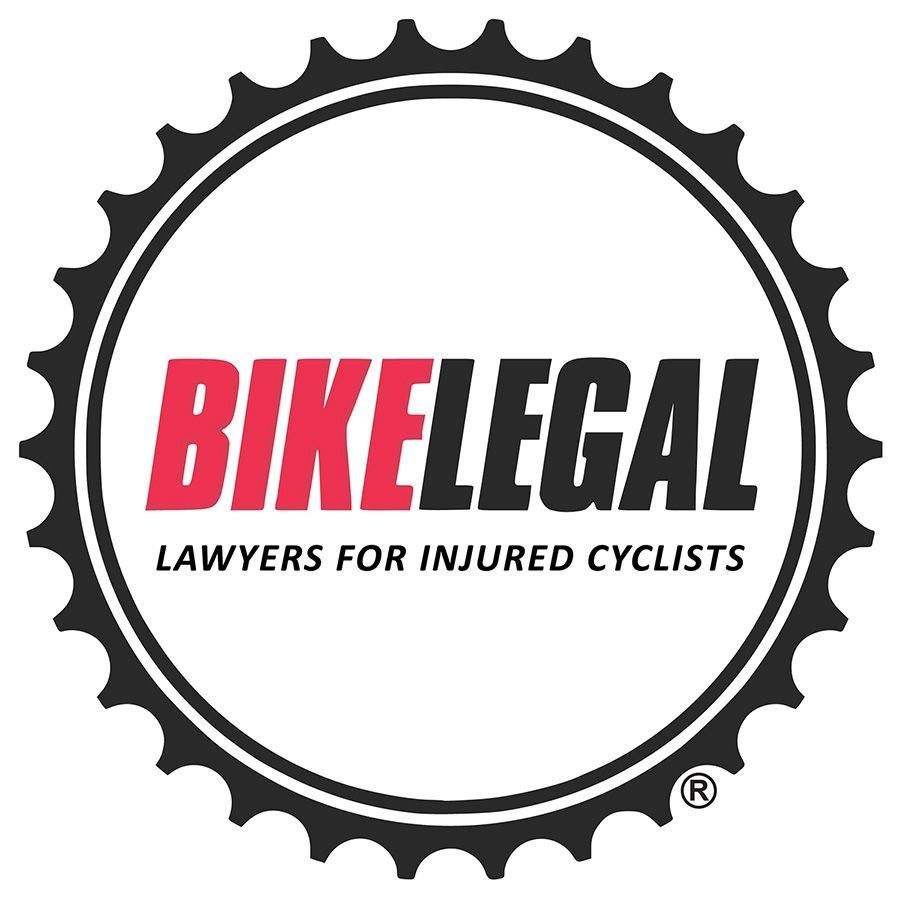
At Bike Legal, we’re cyclists representing cyclists. With unmatched expertise in bicycle accident law and a deep understanding of cycling, we fight to secure justice and fair compensation for injured cyclists. Beyond legal representation, we’re passionate advocates for bicycle safety and education.
If you or someone you know has been involved in a cycling accident, Contact us today for a free consultation.
CALL 877-BIKELEGAL (877-245-3534)
FAQs
Do I really need winter bike tires?
Yes, if you plan to ride in temperatures below 40°F (4°C) or in areas with snow, ice, or slush. Summer tires harden in cold weather and lose their grip, making them dangerous to ride on in winter conditions. Winter road bike tires are designed with special rubber compounds that stay pliable in the cold and tread patterns that provide better traction.
Can I ride tubeless tires in winter?
Absolutely. Tubeless tires are a great option for winter riding. They can be run at lower pressures for increased traction on snow and ice, and they are less susceptible to pinch flats. If you plan on riding in icy conditions, you can also install studs in tubeless-compatible tires.
How do studded bike tires work?
Studded bike tires have small metal studs embedded in the tread. These studs dig into ice and packed snow, providing significantly improved traction. They work similarly to how winter tires on cars use studs for grip. They are most effective on pure ice.
Read Next:
RECENT ARTICLES
Need Us?
We're Here for You
Contact Us
We will get back to you as soon as possible
Please try again later
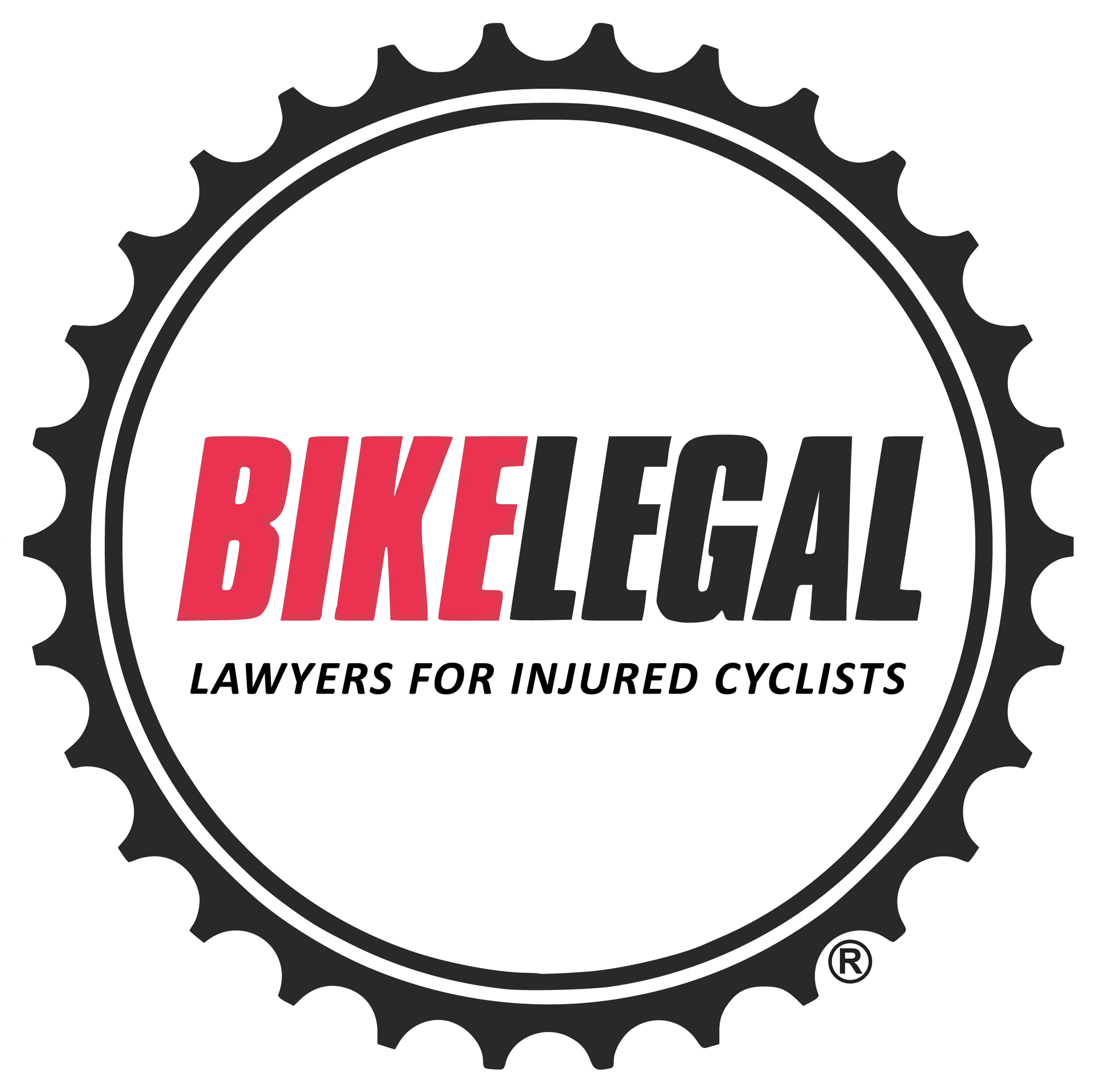
Ride Protected. Ride Safe, with Bike Legal
At Bike Legal our mission is to advocate for bicycle safety and sharing the road responsibly through education. Our legal team is committed to supporting and representing cyclists across the United States no matter where you ride or how you ride.

Contact Info
Headquarters
Bike Legal, APC
17461 Derian Avenue-Ste. 203
Irvine, CA 92614
All Rights Reserved | Bike Legal